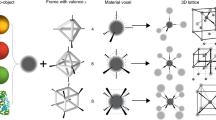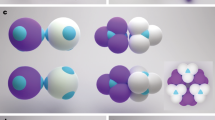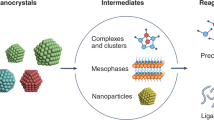Abstract
Colloidal nanocrystal synthesis provides a powerful approach for creating unique nanostructures of relevance for applications. Here, we report that wurtzite ZnSe nanorod couples connected by twinning structures can be synthesized by means of a self-limited assembly process. Unlike for individual nanorods, the band-edge states calculated for the nanorod couples are predominantly confined to the short edges of the structure and this leads to low photoluminescence polarization anisotropy, as confirmed by single-particle fluorescence. Through a cation-exchange approach, the composition of nanorod couples can be readily expanded to additional materials, such as CdSe and PbSe. We anticipate that this family of nanorod-couple structures with distinct compositions and controlled properties will constitute an ideal system for the investigation of electronic coupling effects between individual nanorod components on the nanoscale, with relevance to applications in optics, photocatalysis and optoelectronic devices.
This is a preview of subscription content, access via your institution
Access options
Subscribe to this journal
Receive 12 print issues and online access
$259.00 per year
only $21.58 per issue
Buy this article
- Purchase on Springer Link
- Instant access to full article PDF
Prices may be subject to local taxes which are calculated during checkout





Similar content being viewed by others
References
Lehn, J. M. Toward self-organization and complex matter. Science 295, 2400–2403 (2002).
Wang, T. et al. Self-assembled colloidal superparticles from nanorods. Science 338, 358–363 (2012).
Banin, U. & Sitt, A. Superparticles get complex. Nature Mater. 11, 1009–1011 (2012).
Rubinstein, I., Steinberg, S., Tor, Y., Shanzer, A. & Sagiv, J. Ionic recognition and selective response in self-assembling monolayer membranes on electrodes. Nature 332, 426–429 (1988).
Fan, H. et al. Self-assembly of ordered, robust, three-dimensional gold nanocrystal/silica arrays. Science 304, 567–571 (2004).
Miszta, K. et al. Hierarchical self-assembly of suspended branched colloidal nanocrystals into superlattice structures. Nature Mater. 10, 872–876 (2011).
Xia, Y. et al. Self-assembly of self-limiting monodisperse supraparticles from polydisperse nanoparticles. Nature Nanotech. 6, 580–587 (2011).
Tang, Z., Kotov, N. A. & Giersig, M. Spontaneous organization of single CdTe nanoparticles into luminescent nanowires. Science 297, 237–240 (2002).
Pradhan, N., Xu, H. & Peng, X. Colloidal CdSe quantum wires by oriented attachment. Nano Lett. 6, 720–724 (2006).
Cho, K. S., Talapin, D. V., Gaschler, W. & Murray, C. B. Designing PbSe nanowires and nanorings through oriented attachment of nanoparticles. J. Am. Chem. Soc. 127, 7140–7147 (2005).
Pacholski, C., Kornowski, A. & Weller, H. Self-assembly of ZnO: From nanodods to nanorods. Angew. Chem. Int. Ed. 41, 1188–1191 (2002).
Yu, J. H. et al. Synthesis of quantum-sized cubic ZnSe nanorods by the oriented attachment mechanism. J. Am. Chem. Soc. 127, 5662–5670 (2005).
Koh, W. K., Bartnik, A. C., Wise, F. W. & Murray, C. B. Synthesis of monodisperse PbSe nanorods: A case for oriented attachment. J. Am. Chem. Soc. 132, 3909–3913 (2010).
O’Sullivan, C. et al. Spontaneous room temperature elongation of CdS and Ag2S nanorods via oriented attachment. J. Am. Chem. Soc. 131, 12250–12257 (2009).
Kong, X. Y., Ding, Y., Yang, R. & Wang, Z. L. Single-crystal nanorings formed by epitaxial self-coiling of polar nanobelts. Science 303, 1348–1351 (2004).
Tang, Z., Zhang, Z., Wang, Y., Glotzer, S. C. & Kotov, N. A. Self-assembly of CdTe nanocrystals into free-floating sheets. Science 314, 274–278 (2006).
Schliehe, C. et al. Ultrathin PbS sheets by two-dimensional oriented attachment. Science 329, 550–553 (2010).
Ithurria, S. et al. Colloidal nanoplatelets with two-dimensional electronic structure. Nature Mater. 10, 936–941 (2011).
Ithurria, S., Bousquet, G. & Dubertret, B. Continuous transition from 3D to 1D confinement observed during the formation of CdSe nanoplatelets. J. Am. Chem. Soc. 133, 3070–3077 (2011).
Penn, R. L. & Banfield, J. F. Imperfect oriented attachment: Dislocation generation in defect-free nanocrystals. Science 281, 969–971 (1998).
Banfield, J. F., Welch, S. A., Zhang, H., Ebert, T. T. & Penn, R. L. Aggregation-based crystal growth and microstructure development in natural iron oxyhydroxide biomineralization products. Science 289, 751–754 (2000).
Ma, W. et al. Chiral plasmonics of self-assembled nanorod dimers. Sci. Rep. 3, 1934 (2013).
Gibaud, T. et al. Reconfigurable self-assembly through chiral control of interfacial tension. Nature 481, 348–351 (2012).
Evers, W. H. et al. Low-dimensional semiconductor superlattices formed by geometric control over nanocrystal attachment. Nano Lett. 13, 2317–2323 (2013).
Mokari, T., Rothenberg, E., Popov, I., Costi, R. & Banin, U. Selective growth of metal tips onto semiconductor quantum rods and tetrapods. Science 304, 1787–1790 (2004).
LaMer, V. K. & Dinegar, R. H. Theory, production and mechanism of formation of monodispersed hydrosols. J. Am. Chem. Soc. 72, 4847–4854 (1950).
Baker, J. L., Widmer-Cooper, A., Toney, M. F., Geissler, P. L. & Alivisatos, A. P. Device-scale perpendicular alignment of colloidal nanorods. Nano Lett. 10, 195–201 (2010).
Titov, A. V. & Kral, P. Modeling the self-assembly of colloidal nanorod superlattices. Nano Lett. 8, 3605–3612 (2008).
Wang, Z. et al. Reconstructing a solid-solid phase transformation pathway in CdSe nanosheets with associated soft ligands. Proc. Natl Acad. Sci. USA 107, 17119–17124 (2010).
Peng, X. et al. Shape control of CdSe nanocrystals. Nature 404, 59–61 (2000).
Hadar, I., Hitin, G. B., Sitt, A., Faust, A. & Banin, U. Polarization properties of semiconductor nanorod heterostructures: From single particles to the ensemble. J. Phys. Chem. Lett. 4, 502–507 (2013).
Hu, J. et al. Linearly polarized emission from colloidal semiconductor quantum rods. Science 292, 2060–2063 (2001).
Son, D. H., Hughes, S. M., Yin, Y. & Alivisatos, A. P. Cation exchange reactions in ionic nanocrystals. Science 306, 1009–1012 (2004).
Luther, J. M., Zheng, H., Sadtler, B. & Alivisatos, A. P. Synthesis of PbS nanorods and other ionic nanocrystals of complex morphology by sequential cation exchange reactions. J. Am. Chem. Soc. 131, 16851–16857 (2009).
Li, H. et al. Sequential cation exchange in nanocrystals: Preservation of crystal phase and formation of metastable phases. Nano Lett. 11, 4964–4970 (2011).
Du, H. et al. Optical properties of colloidal PbSe nanocrystals. Nano Lett. 2, 1321–1324 (2002).
Carbone, L. et al. Synthesis and micrometer-scale assembly of colloidal CdSe/CdS nanorods prepared by a seeded growth approach. Nano Lett. 7, 2942–2950 (2007).
Talapin, D. V. et al. Seeded growth of highly luminescent CdSe/CdS nanoheterostructures with rods and tetrapod morphologies. Nano Lett. 7, 2951–2959 (2007).
Sitt, A., Salant, A., Menagen, G. & Banin, U. Highly emissive nano rod-in-rod heterostructures with strong linear polarization. Nano Lett. 11, 2054–2060 (2011).
Acknowledgements
The research leading to these results has received financial support from the European Research Council under the European Union’s Seventh Framework Programme (FP7/2007-2013)/ERC grant agreement no. (246841). U.B. thanks the Alfred and Erica Larisch Memorial Chair. G.J. thanks the NSFC (11004177) for travel support. A.S. thanks the Fulbright foundation for their support.
Author information
Authors and Affiliations
Contributions
G.J. and U.B. designed the experiments and wrote the manuscript. G.J. carried out the experiments, materials characterization and analysis. A.S. carried out the electronic structure calculations. I.H. and G.B.H. carried out single-particle photoluminescence polarization and AFM measurements. Y.B. performed the calculation of interactions between two nanorods. Y.A. carried out SEM measurements. I.P. assisted with HRTEM measurements and structural analysis. All authors discussed the data and the mechanisms, and commented on the manuscript.
Corresponding authors
Ethics declarations
Competing interests
The authors declare no competing financial interests.
Supplementary information
Supplementary Information
Supplementary Information (PDF 2628 kb)
Rights and permissions
About this article
Cite this article
Jia, G., Sitt, A., Hitin, G. et al. Couples of colloidal semiconductor nanorods formed by self-limited assembly. Nature Mater 13, 301–307 (2014). https://doi.org/10.1038/nmat3867
Received:
Accepted:
Published:
Issue Date:
DOI: https://doi.org/10.1038/nmat3867
This article is cited by
-
Breaking the symmetry of colloidal 2D nanoplatelets: Twist induced quantum coupling
Nano Research (2023)
-
Hollow nanoparticles synthesized via Ostwald ripening and their upconversion luminescence-mediated Boltzmann thermometry over a wide temperature range
Light: Science & Applications (2022)
-
Nanoparticle surfactants for kinetically arrested photoactive assemblies to track light-induced electron transfer
Nature Nanotechnology (2021)
-
Comparative Study of Selenides and Tellurides of Transition Metals (Nb and Ta) with Respect to its Catalytic, Antimicrobial, and Molecular Docking Performance
Nanoscale Research Letters (2020)
-
A welding phenomenon of dissimilar nanoparticles in dispersion
Nature Communications (2019)



